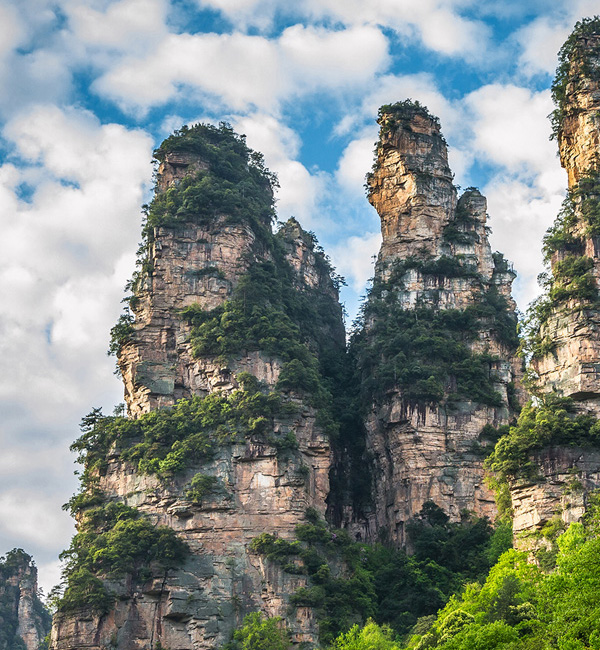
On the earth, there are mainly karst stone forest landforms and Danxia landforms similar to the sandstone peak forest in Zhangjiajie, and there are only about four landforms in the world that can be compared with the sandstone peak forest in Zhangjiajie:
Bemala Hachingi Strict Nature Reserve, Madagascar
Muru National Park in Moonguna, Sarawak, Malaysia
Palawan Island, Philippines
Mount Kaijingde, Papua New Guinea
Common features of these four sword-shaped karst landforms are:
It is an island or coastal environment, and it is distributed in the tropical zone within 20° north and south latitude. The developmental period is from the Late Tertiary period. The origin is relatively simple, all of them are formed by the surface erosion of limestone; It has significant biodiversity, representing ecosystems and unique flora and fauna of different environments in the tropics, with abundant rainfall.
Zhangjiajie sandstone peak forest landform is unique in the world, with large relative height difference, large high diameter, large column density, interlayer between soft and hard, strange column shape, lush vegetation, rare dynamic value, and a wide variety of other characteristics. In particular, it has a unique and well-preserved standard mode of peak forest formation, namely platform, square mountain, peak wall, peak forest, peak cluster, etc. The remnant forest forms a systematic geomorphic landscape, which is perfectly reflected in this area, and still maintains a natural ecological environment system that is almost undisturbed.
Zhangjiajie Global Geopark mainly develops sandstone peak forest landform and karst landform, among which sandstone peak forest landform is very spectacular in the world. The sandstone peak forest landform in the park contains sand and stone mountain columns, square mountain fortress, bridge stone gate, barrier valley gullies, karst canyons, karst caves, spring waterfalls, streams and lakes and sediments, structures, stratigraphic sections, paleontological fossils and other colorful geological relics.
There are over 3000 towering peaks and pillars in the park, ranging from tens of meters to 400 meters in height, with over 1000 of them exceeding 200 meters in height.
Zhangjiajie sandstone peak forest landform is very rare in the world mountain landscape, is rated as one of the most beautiful mountain landscape in China.
Karst cave landform is another important type of geological relics in the park, there are dozens of large and small caves, of which Huanglong Cave is the most representative.
Developed in the Upper Paleozoic Triassic limestone and dolomitic limestone strata, Huanglong Cave consists of 5 interconnected karst caves with a total height of 160m and a total length of more than 30km, making it one of the longest caves in the world. In the cave, various holes, side grooves, stone buds and various forms of chemical deposits are very developed, including stalactites, stalagmites, stone pillars, stone curtains, stone waterfalls, stone flags, stone curtains, stone terraces, stone branches, goose tubes, six POTS (lotus POTS), cave beads, stone golden flowers, huabai, etc. Among them, stalagmites are up to 22m, with a maximum diameter of 9m. The long corridor, hall, hidden river and waterfall of Huanglong Cave form an intricate underground maze, forming a magical landscape of "water in the cave", "water cave", "Cave Zhongshan" and "mountain cave". The formation process of Huanglong Cave reflects the characteristics of regular and rhythmic intermittent uplift of neotectonic movement in northwestern Hunan. The karst types of the cave are complete, showing the typical characteristics of karst cave.
Mr. Sansel, senior adviser to the United Nations World Heritage Acceptance Committee, called it "the most concentrated stalagmites and the most realistic place seen in the cave."”

Spatial distribution of sandstone platforms, square mountains, peak clusters, peak walls, peak forests, pillar peaks, stone gates, deep valleys, streams, self-generated Bridges, mountain traverses, and linear sky in the park is typical and systematic, indicating that the landscape of Zhangjiajie sandstone peak forest is a vertical or near-vertical erosion cut by surface water along the smooth occurrence and huge thickness of landscape quartz sandstone. The rock strata gradually dismembered and separated, and experienced a dynamic development process from the original structural plane to the platform, the square mountain landform, the peak cluster, the peak forest landform, the slope residual peak pillar forest, and the new denudation landform.
This is a rare and unique landform formed under the conditions of specific geological structure, specific neotectonic movement and external force, Zhangjiajie Global Geopark is therefore regarded as a natural laboratory of surface process evolution. A unique and rare geological geomorphic remains.